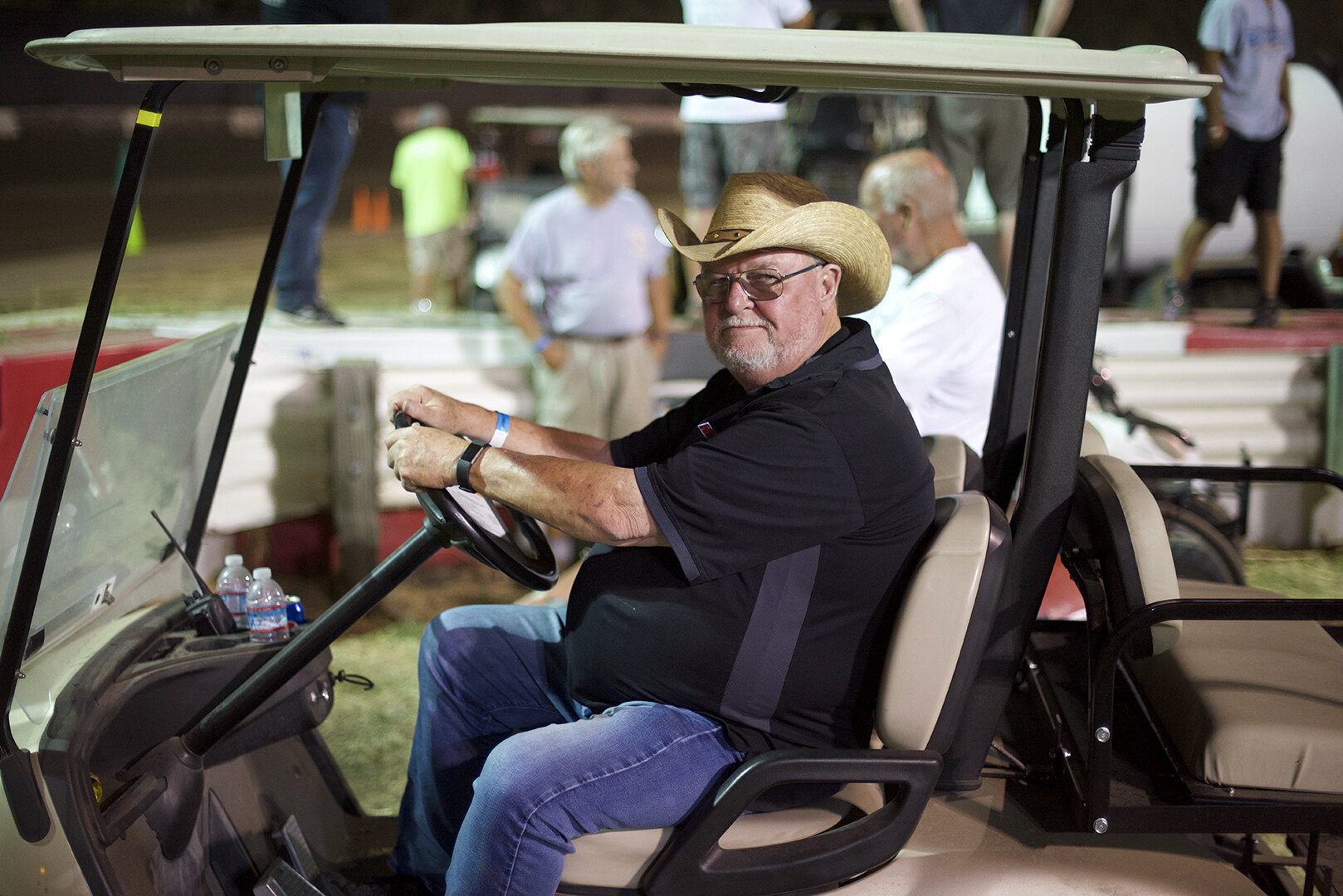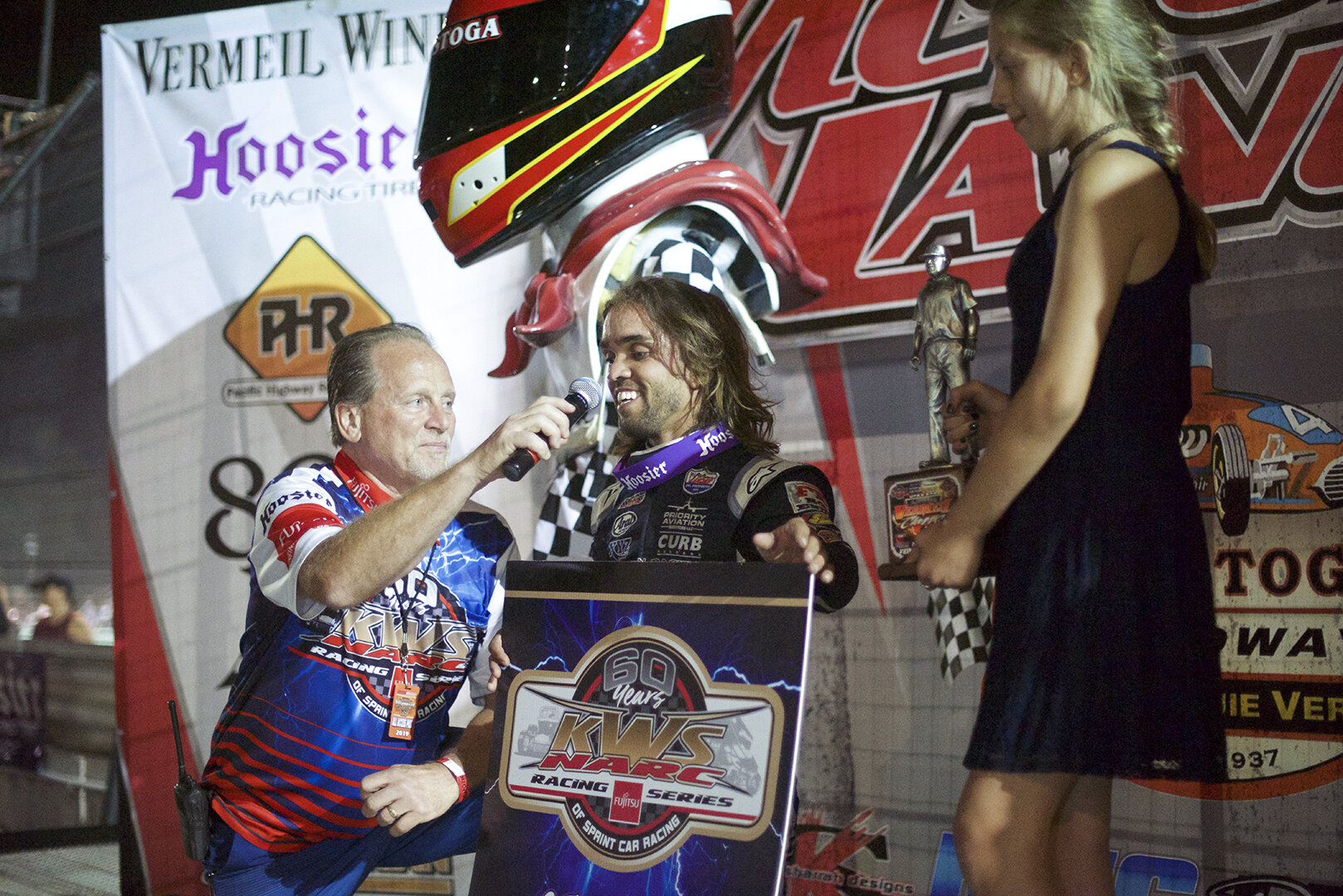Impressions of a Sprint Car Race
Rico Abreu pulling away on a restart as the field slides through turns one and two chasing him. Abreu was the class of the feature event and won going away.
On the 2019 Louis Vermeil Classic
Text + Photos: Mike Blanchard
Spotlight | The Louis Vermeil Classic rolled into the Calistoga Fairgrounds Labor Day weekend. At just under a half-mile, Calistoga is the fastest dirt track on the West Coast. The race featured an all-sprint-car program for the USAC/CRA wingless 410s and the winged King of the West series 410 cars.
The Louis, as it is known, is promoted by Tommy Hunt, son of famed magneto king and car owner Joe Hunt. Hunt put up a $24,000 purse to be divided by the winners over the course of the two nights as well as a $2,000 prize for the driver who wins on the same night in both wingless and winged cars. With bonuses put up by sponsors and manufacturers, there was some good money to be picked up.
• Related: Tommy Hunt
The race is a popular one with Nor Cal race fans and it is almost impossible to get a room in the area on race weekend. Of course it is Calistoga on Labor Day weekend, so ... Even so, the stands were full and the crowd very enthusiastic and knowledgeable. This is big time racing but like virtually all racing, it is, at its heart, family-based. Many of the racers are second-, third- or even fourth-generation racers.
Nathan Rolfe pulling a wheelie down the back stretch in his heat race. Rolfe finished 13th in the feature. These cars make over 800 horse power. They are very light with a short wheel base giving them explosive acceleration.
The race is held in honor of famed racer and promotor Louis Vermeil, who raced in the first Calistoga race and promoted racing at the track for many years. This space is too small to document the impact Vermeil had on racing in Northern California in general and Calistoga in particular. Do yourself a favor and look him up.
Hunt has spent a great deal of effort on safety and the track itself over the years. There are NASCAR-style safety barriers and catch fencing. The track butts up to a residential neighborhood in the downtown area, and noise is a big issue for the neighbors. As a result there is a curfew of 11 pm.
Saturday night after the heat races the track crew got out the tractors and inexplicably took more than an hour to re-groom the track, which pushed the program late and caused the main event to be suddenly shut off at 11, about four laps short of the full length. The promotor is subject to fines if the curfew is broken.
Promoter Tommy Hunt keeps an experienced eye on the proceedings from the end of the pit lane.
The Hoosier Tire trailer. Modern sprint car tires are surprisingly thin. They come collapsed and bundled up. The most important tire is the right rear.
As might be expected, this led to great confusion among the racers, crews and fans as to who was the winner. The Sunday race program ran smoothly to schedule.
For those of you who have not attended a sprint car race, once the pre-race track grooming is finished the cars come out and circulate slowly, wheel packing the loamy track surface down into a hard groove.
At first the cars almost idle around. They gradually speed up, throwing great rooster tails of mud from the open race tires. As the track surface hardens the drivers begin running full throttle and pitching the cars sideways through the turns, depositing a blue black skim of rubber on the main racing line. Then the cars all pit, scrape off the mud, and get on with the time trials and heat races.
The USAC cars have a nasty visceral bark to the exhaust. They don’t run even the vestigial mufflers the wing cars use. Because they have much less grip than the wing cars, the drivers throw them into lurid slides as they go ’round the corner.
Bill Crowley’s 1930 sprint car. It started life as a three springer built by the Scovall brothers and ran in the first race at Calistoga in 1937. The body is hand hammered aluminum.
As fun as the wingless cars are to watch, the wing cars are significantly faster and they go through the corners in a different manner. The downforce generated by the wings means the cars don’t slide as much through the turns and they are several seconds a lap faster than the USAC cars. It’s terrifying and thrilling to stand on the inside of the turn as they pass by at full chat.
The 410 cars make 800-plus horsepower and it is not uncommon to see the cars pulling power-wheelies down the straights, hitting well over 100 mph as they pitch into the corner.
During a break from the pro racing, a group of vintage cars, including track roadsters, midgets and big cars, took to the track and gave the spectators a glimpse of days gone by.
Bill Crowley brought out his beautiful black number 88 sprinter built in 1930 by Art and Ray Scovall. It features a Ford B block with a McDowel single-cam head on it. The car ran in the first Calistoga race in 1937. Crowley’s wife and daughter comprised his pit crew. Tommy Rand helped Crowley with tuning the car, which was being run for the first time in 50 years.
Vintage track roadster in action. These were made from Ford Model T roadsters and were very popular in their day.
Bill Crowley wheeling the number 88 through turn one and two.
In the USAC main event, six time champion Damion Gardner, who is battling for the 2019 championship with Brody Roa, was a fan favorite for the win. But at the finish it was Jake Swanson in the No. 34 car who pipped the field. Swanson, who had a big crash the night before, had a proper ding-dong with Ryan Bernal before finally getting by for good on lap 23. Jason McDougal snagged the final podium spot.
In the winged car race Sunday night, Rico Abreu was the class of the field, setting fast lap, bagging pole position and leading every lap of the race going away. The popular local driver pulled out a big lead at the start and did the same during the three restarts of the race. Former winners Bud Kaeding, Shane Golobic and Dominic Scelzi put on a good show as they battled for final podium spots.
In the end there was Abreu on the podium celebrating his 11th win at Calistoga (in both winged and wingless cars) with a bunch of kids standing around him, clearly in his element, while fans took pictures and cheered. And then everyone got to packing up the cars and equipment.
Rico Abreu celebrating his 11th win at Calistoga. The trophy girl (Leroy Van Conett’s great grand daughter Kailey) holds the coveted Louis statue.
Bud Kaeding thanks the fans as he mounts the podium to celebrate a well earned second place finish in the wing car race.









